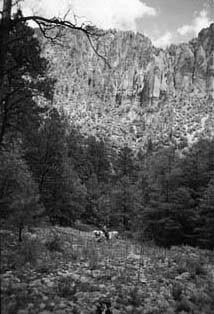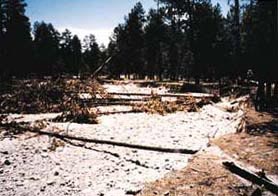|
|
|
| Subscriptions click here for 20% off! | E-Mail: info@rangemagazine.com |
|
|
||||||||||||
 |
||||||||||||
The Glenn
|
||||||||||||
| Ida Campbell on “Dusty” about one mile above Straw Canyon, 1960. This gravel bar was one of the largest on the West Fork at the time. This was one of the few places we could photograph the cliffs without trees in the way. | ||||||||||||
| In 1924, 438,360 acres of the forest lands in Southwest New Mexico
were set aside as the first wilderness designation on the North
American continent. Now known as the Gila Wilderness the region
was chosen by Congress, “So that this and future generations may
see and enjoy the wilderness as it was when first explored by
the pioneers.” At least that’s what the big brown sign at the
entrance to the forest says. The Gila National Forest is home to a little over a hundred ranches, a few of them still operate in the wilderness areas of the forest. Most of these ranches were in place before the wilderness designation and remain small, family run operations. Kids are considered part-time employees. Mothers are business managers, bookkeepers and cooks, while fathers ramrod the outfits. In the early ’90s, things began to turn for ranchers operating in the Gila. It became harder and harder to get allotment management plans approved by the U.S. Forest Service. Almost overnight, having a successful, productive operation and keeping your cattle in compliance with your allotment management plan (AMP) wasn’t enough to satisfy government requirements for the allotment. Especially if your allotment had any wilderness attached to it. When someone in Washington decided allotment management planning fell under the rule of NEPA (National Environmental Policy Act of 1969) compliance it opened a can of worms that no one can see to the bottom of. Instead of just allowing public input comments when they reissued the annual forest plan, the Forest Service began redefining the NEPA compliance process to involve public comment on individual AMPs. Ranchers found themselves caught between making their mortgage payments and complying with management standards that were becoming unreasonable, unprofitable and impossible to comply with. The larger wilderness-based operations were singled out by environmental extremists and the owners were forced to plan their grazing rotations with these groups who, in turn, were screaming for the removal of cattle. The Forest Service soon followed suit, citing the need to let the grazing lands of the forest rest. As things accelerated in the anti-grazing movement, the makeup of the Forest Service began to change. Rather than try to manage the land as they had been mandated by Congress, for the stability of the communities, providing for a sustained yield of timber and the health of the range and watershed, they began managing for endangered species, tourism and special interests. Wildlife biologists were hired and put in charge of the district range departments, either totally eliminating the local range conservationist or delegating him to a back seat on the trip the Forest Service was taking through the land of preservation. Ranchers were powerless to defend their grazing allotments from the combined forces of bureaucracy and special interest. With the claim that riparian areas would regenerate if cattle were removed, the larger ranches fell by the wayside as grazing allotments were phased out of the Gila. It got to the point that if an allotment was targeted by anyone green, the owner of the ranch sometimes decided he would be better off selling his cattle and taking voluntary non-use. A side-effect the greens never considered in their haste to do away with the cattle was that ranchers with enough private land were forced to subdivide their old family holdings as the only way to provide income for their families as well as retain the value of the ranch property. The Forest Service, allied with groups such as The Center for Biological Diversity, Gila Watch, Forest Guardians, Rest the West, Wilderness Watch and the Sierra Club, removed cattle no matter what anyone did. An attempt to fight what seemed to be an arbitrary decision led to Forest Service fines for trespass. Any lawsuit filed by an allotment holder led to a vendetta against the rancher filing the suit, making it much harder, if not impossible, for a rancher to regain use of any portion of the allotment after the so-called rest period was up. The loss of taxes brought in by livestock caused suffering in the communities that relied on income from public land use. Schools and local government services were running out of funding. If grazing was not responsible for the deterioration of the watershed and range someone had to figure out what the problem was. Kit Laney, and Matt Schneberger, both ranchers and allotment holders in the Gila, began discussing the possibility that cattle weren’t the cause of the damage to the allotments. They were aware some of the forest allotments seemed to have deteriorated in the past 30 years, though hardly to the extent claimed by green groups and the Forest Service. Both ranchers ran high country operations and had noticed over the years the open grasslands were shrinking. At the same time, they were aware of ungrazed areas that seemed to be deteriorated as well. Neither of them understood why cattle were being singled out as the primary culprit for the erosion and riparian regeneration problems they were seeing on the Gila. There was only one way to find out what removal of grazing would accomplish and whether it was reasonable to consider it a partial solution. The way to do this was to find an old ranch, preferably wilderness, that hadn’t been grazed for a while and compare it to their own allotments. This way they could come up with a reasonable approach to begin repairing damage on the forest allotments that were left, before livestock removal became the only solution to what they believed was really a multi-dimensional problem. The only allotment that met all of the requirements in the Gila was the Glenn. When Kit and Matt approached Forest Service officials in Silver City and requested a cooperative tour of the Glenn, they weren’t greeted with much enthusiasm; in fact, they were totally ignored. After another year of watching their neighbors go down in flames and Kit, owner of the largest wilderness based allotment in the Gila, was facing some serious cow reductions himself, they decided they couldn’t wait any longer. They convinced the board of directors of the Gila Forest Permittees to fund a private tour of the Glenn, and went to the New Mexico Department of Agriculture to discuss their plan with the director, Ronald White. White was excited at the prospect of viewing the Glenn. Coincidentally, he had lived on the Glenn in the ’60s while working for the New Mexico Dept. of Game and Fish. It looked like the plan was coming together. The Gila Permittees contacted owners of the Gila Hot Springs Guide and Outfitters, David and Becky Snow, and contracted them as guides through the allotment. Becky’s outfitting business bordered the Glenn and her family had taken trail rides through the allotment for years. Her father had run the business back in the days when the Glenn still ran cattle. By the summer of 1995, they were ready. The first tour started out at the Gila Hot Springs Guide and Outfitters headquarters. The party sat around the table looking over Becky’s old pictures and planning the route they would take. Though they were invited, Silver City forest officials declined to accompany them. The allotment was large enough that the tour was done in two trips, both lasting four days. When it was finished, the party had what they considered evidence that would not only help the local ranchers, but would also lead the Forest Service to implement changes that might begin repairing the watershed damage the Gila had suffered over the years. Most important, Kit and Matt felt they could finally show the Forest Service that grazing was not the cause of the minor damage the Gila’s grazing allotments were seeing, and they had plenty of evidence to back them up. “The Glenn shocked us,” said Matt. “Compared to other allotments, it looked like a Red Cross disaster area.” The West Fork of the Gila River, formerly a fisherman’s paradise as seen in Becky’s old pictures, was a shadow of its former self. Grass and cottonwoods no longer |
||||||||||||
 |
||||||||||||
 |
||||||||||||
| LEFT: The riparian area in this grazed allotment after two weeks of rest from cattle is much healthier than the ungrazed Glenn allotment. ABOVE: This is the Glenn allotment Little Creek riparian area after 48 years with no grazing. The lack of grass coverage has allowed riparian areas to deteriorate. | ||||||||||||
|
covered the ground and shaded the water, providing habitat for
fish and other aquatic species. Instead, the banks of the river
were scoured of any green vegetation. Flood plains were up to
300 feet wide, cobbled with stones and boulders, and, in places,
eroded right down to bedrock. Cutbanks and washed out trees were
commonplace, and the water–shallow and unshaded–was warm enough
to grow algae. Every tributary on the Glenn was eroded and denuded
of any vegetation with the exception of ponderosa pine. Laura Schneberger has a small family cow/calf operation in the Gila National Forest and is president of Gila Forest Permittees. |
||||||||||||
|
To Subscribe: Please click here for subscription or call 1-800-RANGE-4-U for a special web price Copyright © 1998-2005 RANGE magazine last page update: 04.03.05 |
||||||||||||
